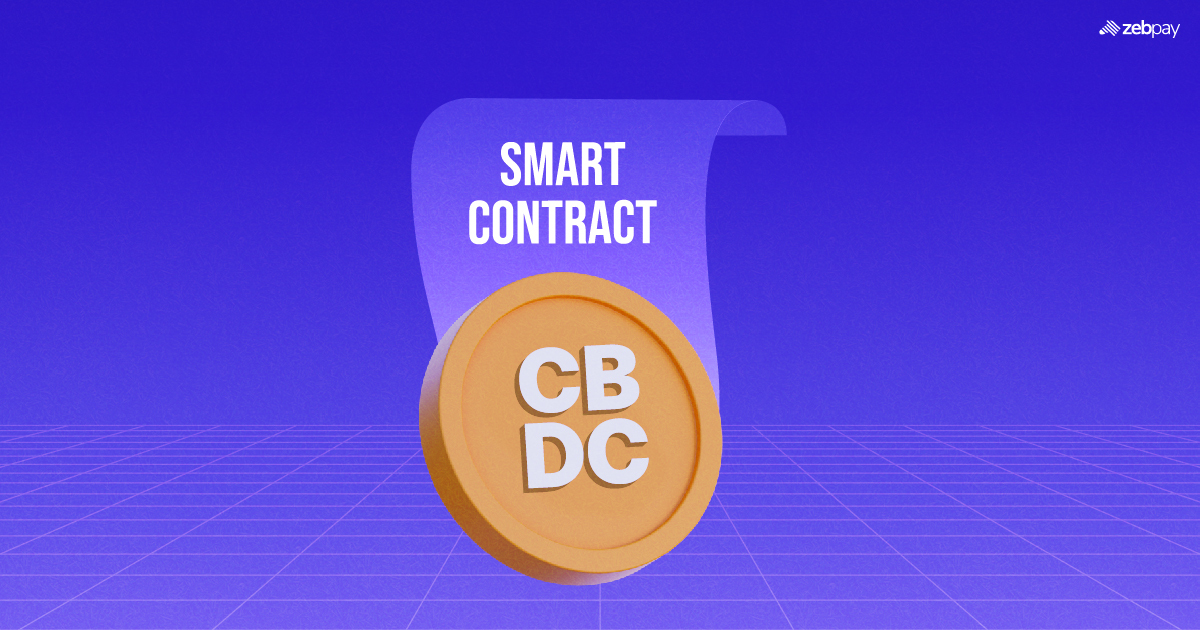CBDCs represent digital versions of traditional fiat currencies and are created by central banks for purposes such as settlement, payment, and medium of exchange. They can be utilized in various ways, including the incorporation of Smart contracts. Smart contracts, and computer protocols enabling the enforcement, management, or negotiation of contracts, offer diverse applications. These contracts can automate the execution of actions based on predetermined conditions, transforming the way business processes occur in various sectors, including the financial services industry. In banking and financial institutions, Smart contracts streamline processes, enhance efficiency, and reduce the risk of fraudulent claims.
The decentralized ledgers of blockchain networks facilitate automated validation and self-regulatory transactions, ensuring transparency and eliminating the need for extensive human intervention, ultimately reducing long-term transaction costs. This blog will explore the possible synergy between CBDCs and Smart contracts that could lead to new financial innovations.
Central Bank Digital Currencies (CBDCs) in Brief
A central bank digital currency (CBDC) is a digital rendition of government-backed fiat money issued by a central bank and linked to the national currency of a country. CBDCs share similarities with stablecoins and crypto pegged to fiat money, with the vital distinction being that CBDCs are issued by governments worldwide.
Each CBDC represents a digital form of a country’s fiat currency and operates similarly, although variations may exist among countries developing their CBDCs. The central bank issues its CBDC, backed by the federal government, and it functions as a legal tender for transactions like wage payments or purchases of goods and services.
Some essential features of CBDCs include
Convenience:
CBDC payments aim to be highly convenient, akin to using cash, involving actions such as scanning a QR code or swiping a card. This convenience promotes accessibility and adoption.
Low Cost:
CBDC payments should be available at extremely low or zero costs for end-users, minimizing technological investment requirements.
Convertibility:
CBDCs should be easily exchangeable at par with private money or cash, preserving the currency’s uniqueness.
Security:
The CBDC system, including its infrastructure and participants, should maintain robust resistance against cyber threats and other risks. Effective safeguards against counterfeiting are also crucial.
Instant Settlement:
CBDCs should facilitate instant or near-real-time settlement for all end-users within the system.
Smart Contracts: Concept and Functionality
Smart contracts are digital protocols designed to facilitate, validate, or execute an agreement through computer processes. Operating on the blockchain platform, these contracts manage all transactional aspects independently, eliminating the need for intermediaries. Similar to traditional contracts, smart contracts define rules and penalties governing an agreement and enforce these obligations automatically. Multiple Smart contracts can be integrated to work collectively.
Advantages of Smart Contracts:
Autonomy and Cost Savings:
Smart contracts operate without brokers or intermediaries, reducing the risk of third-party manipulation and resulting in significant cost savings.
Safety:
Smart contracts employ encryption, ensuring documents remain secure and protected from unauthorized access.
Speed:
Automation through computer protocols in smart contracts accelerates various business processes, saving significant time.
Accuracy:
Smart contracts eliminate errors associated with manual form filling, enhancing overall accuracy in transactions.
Read more: Future of Smart Contracts
The Interplay of CBDCs and Smart Contracts
Central Bank Digital Currencies (CBDCs) are gaining traction as many countries are considering their implementation. However, executing CBDCs necessitates a robust and secure transaction management system, and this is where blockchain technology becomes pivotal. Blockchain, offering a secure and decentralized system, emerges as an ideal solution for CBDC implementation. A key component of blockchain that proves indispensable for CBDCs is the utilization of smart contracts.
Smart contracts, self-executing agreements programmed to activate under specific conditions, constitute the backbone of blockchain technology and are instrumental in CBDC implementation. These contracts, integrated into the blockchain, facilitate transactions without the involvement of intermediaries, ensuring efficiency and cost-effectiveness.
The pivotal role of smart contracts in CBDC implementation can be outlined as follows:
Automated Transactions:
Smart contracts can streamline the entire CBDC transaction process, removing the necessity for intermediaries like banks and payment processors. This automation significantly reduces transaction times and costs.
Programmable Conditions:
Smart contracts can be programmed to execute transactions based on predefined conditions, ensuring secure and transparent transactions. For instance, a Smart contract can be configured to execute a transaction only when a specified amount of funds is available in the account.
Transparency:
Smart contracts operate transparently, allowing all involved parties to access transaction details. This transparency safeguards transactions and eliminates the potential for fraud or unauthorized access.
Security:
Smart contracts are tamper-proof, guaranteeing that once a transaction is executed, it remains unalterable. This feature enhances security, eliminating the possibility of fraud or hacking.
Cost-effectiveness:
By eliminating the need for intermediaries, Smart contracts contribute to cost-effectiveness, which is particularly advantageous for individuals and businesses engaged in smaller transactions.
In the CBDC implementation landscape, smart contracts assume a vital role, ensuring secure, efficient, and cost-effective transactions while upholding transparency and obviating the need for intermediaries. As more countries explore CBDC implementation, smart contracts will continue to be integral to ensuring the success of these initiatives.
Read more: Difference Between CBDCs and Digital Money
The Rise of Decentralized Finance

Smart contracts streamline and automate diverse financial processes, minimizing the reliance on manual intervention and enhancing operational efficiency. This automation not only boosts efficiency but also mitigates the risk of human errors. For instance, within lending platforms, smart contracts autonomously execute loan agreements, manage collateral, and handle interest payments, establishing a seamless and dependable process.
In traditional finance, intermediaries play a pivotal role in facilitating transactions. However, decentralized finance (DeFi), driven by smart contracts, eliminates the necessity for these intermediaries. This disintermediation leads to cost reduction, and accelerated transaction speeds, and offers users greater control over their financial activities.
Decentralized lending platforms such as Compound and Aave leverage smart contracts, enabling users to borrow and lend assets without relying on centralized intermediaries. Smart contracts automatically execute interest rates, collateral requirements, and loan repayments, fostering a transparent and efficient lending ecosystem. These decentralized lending and borrowing platforms democratize access to financial services, as Smart contracts empower users to borrow against their crypto holdings, thereby unlocking liquidity.
Read more: CBDC vs Crypto
Automated market makers, a subset of decentralized exchanges, utilize smart contracts to provide liquidity for trading. Platforms like Balancer and Curve leverage algorithms and smart contracts to adjust token prices based on supply and demand. This approach ensures liquidity while eliminating the need for order books and traditional market-making mechanisms.
Regulatory and Legal Implications
The regulatory framework poses a challenge in the implementation of Central Bank Digital Currencies (CBDCs) through Smart contract technology. Crypto and blockchain regulation varies across countries, lacking international consensus on a standardized regulatory approach. This lack of regulatory clarity introduces uncertainty for financial institutions and governments, potentially leading to hesitancy in adopting CBDCs through smart contracts.The regulatory landscape is further complicated by the decentralized nature of Decentralized Finance (DeFi) platforms. Global regulators are wrestling with the application of existing financial laws to these innovative platforms. Striking a delicate balance between promoting innovation and safeguarding users poses a significant challenge for regulators within the DeFi sector.
Establishing clear regulatory frameworks that acknowledge the distinctive characteristics of decentralized finance while ensuring consumer protection is essential for the sustainable development of the CBDC ecosystem.
Case Studies: CBDC-Smart Contract Integration
As blockchain technology continues to transform the financial sector, central banks globally are exploring the feasibility of introducing central bank digital currencies (CBDCs) built on blockchain. The adoption of Smart contract-based CBDCs holds the potential to revolutionize monetary transactions and interactions. Additionally, it could enable central banks to offer more efficient and secure financial services to citizens, empowering them with increased control over their financial activities.
Several case studies provide insights into the advantages and challenges associated with the implementation of smart contract CBDCs.
- China’s Digital Currency Electronic Payment (DCEP) project: Since 2014, China’s central bank has been investigating blockchain-based CBDCs. In 2020, the DCEP project was launched, aiming to create a digital version of China’s fiat currency, the renminbi. The project is currently undergoing trials in major cities like Shenzhen, Suzhou, and Chengdu. DCEP is designed for both online and offline transactions, with anticipated benefits including facilitation of cross-border payments, reduced transaction costs, and enhanced financial inclusion.
- The Bahamas’ Sand Dollar: The Central Bank of The Bahamas pioneered the full deployment of a CBDC with the launch of the Sand Dollar in 2020. Leveraging blockchain technology, the Sand Dollar is crafted to facilitate financial transactions, particularly among the unbanked and underbanked populations in The Bahamas. Noteworthy benefits of the Sand Dollar include lower transaction costs, quicker settlement times, and increased financial inclusion.
Challenges and Future Prospects
While the numerous potential advantages of employing blockchain technology for the implementation of Central Bank Digital Currencies (CBDCs) are evident, various challenges require attention. These challenges encompass not only technical issues but also social and regulatory considerations. This section will delve into some of the potential challenges associated with adopting CBDCs through blockchain technology.
A primary challenge linked to implementing CBDCs via blockchain technology is the matter of scalability. Presently, blockchain networks struggle to manage the transaction volume necessary for a national currency. For instance, the Bitcoin blockchain can only handle seven transactions per second, which falls short of supporting the required transaction volume for a national currency. Another technical challenge involves security concerns. While blockchain technology is recognized for its security features, it is not impervious to attacks. Instances of blockchain networks being compromised, resulting in fund losses, have been documented.
Social challenges also accompany CBDC implementation through Smart contract technology. One notable concern is the potential impact on financial inclusion. Although CBDCs hold the promise of enhancing financial inclusion, they may also exclude individuals lacking internet access or the requisite technology. Moreover, apprehensions about privacy and surveillance arise. Governments and financial institutions may leverage CBDCs to monitor transactions, raising concerns about privacy infringement.
While CBDC implementation via Smart contract technology holds the potential to revolutionize the financial industry, addressing these challenges requires collaborative efforts from governments, financial institutions, and blockchain developers.
Read more: Pros and Cons of CBDCs
Conclusions
The trajectory of central bank digital currencies (CBDCs) and Smart contract technology is a subject that generates considerable interest within the financial sector. While diverse opinions exist regarding the potential impact of CBDCs and Smart contract technology, it is evident that they hold the potential to transform the global financial system.
Although the future of CBDCs and Smart contract technology appears promising, numerous challenges must be addressed before achieving widespread adoption. Nevertheless, as more countries and entities delve into exploring the potential synergies of these technologies, their increasingly vital role in the global financial system becomes apparent.
If you found this blog to be useful, do share it with other like-minded crypto enthusiasts. Click on the button below to begin your crypto trading journey using ZebPay.







